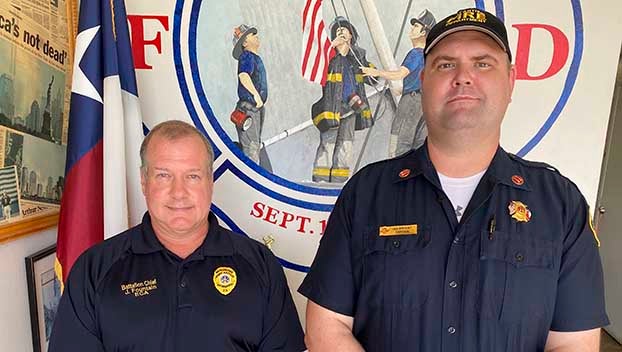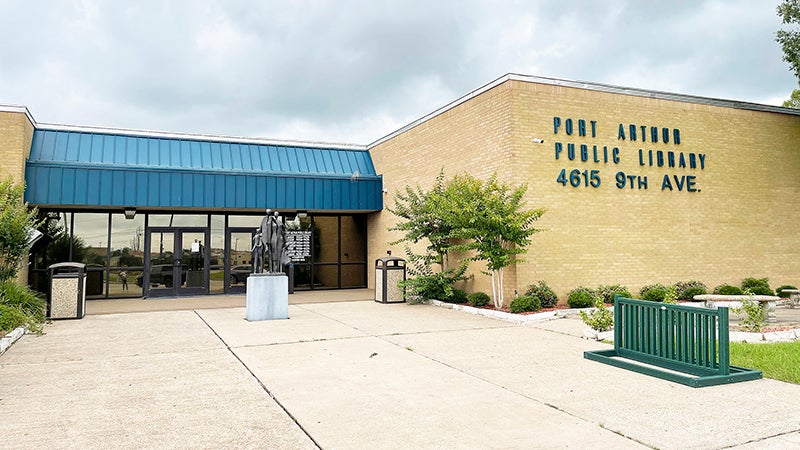HOMETOWN HEROES — Firefighters battle more than flames; talk life-saving actions
Published 12:40 am Friday, June 23, 2023

- Pictured, from left, are Battalion Chief Jay Fountain and Capt. Ian Bryant. (Monique Batson/The News)
|
Getting your Trinity Audio player ready...
|
For some, the desire to help others overshadows the need for self-preservation.
That’s how Port Arthur Fire Department Capt. Ian Bryant described the May 20 fire in the 500 block of 19th Street, which included firefighters saving three lives.
“It’s something you can turn off or don’t think about,” he said. “The mentality of, ‘am I going to live or die.’ You put it to the side, and the mission at hand is important.”
The department received the call at 11:49 p.m. and was advised there were victims in the residence.
“(Battalion Chief Jay Fountain) showed up first and gave a scene size-up,” Bryant said. “There was a lady in the driveway that told him there were two people left inside, and I think she said they were off to the right when you walk in. The fire was in the back side of the house, so the front part had smoke coming through, but there wasn’t any fire in the front of the building quite yet.”
But even without flames, there was no visibility through the smoke.
The first victim to be pulled from the house was a woman who was in cardiac arrest. First responders began CPR in the front yard.

Three people were transported to a local hospital May 20 following a fire in the 500 block of 19th Street. (Courtesy photo)
But there was a second person in the home.
“I heard noise in front of me and I took a couple of steps,” said Capt. Michael Adaway. “I heard a very muffled ‘help.’ It kind of startled me and I took another couple of steps forward and basically fell on top of the victim. He was on a bed that was in the very next room past the front living room, when I basically tripped over him.
“My hand light was on, and it was right in his face. I realized I had the second victim and called out to everyone else, telling everybody that I had the second victim.”
Adaway had the man grab his shoulders as he began to feel his way out of the house.
“I started walking backwards, and there was a very low living room table that I stumbled over,” Adaway said. “Me and the victim fell on the couch. As soon as I landed on the couch, I knew exactly where I was. Three feet to my right was the front door. I grabbed the man again and was just getting across the threshold of the front door when Capt. Bryant picked up his legs and helped me carry him out.”
Fountain said the conditions inside a burning home are nothing compared to what people see on television.
“If you want an accurate depiction, search for firefighter helmet cam videos,” he said. “You’ll see what we actually see.”
Bryant said on arrival, the smoke was already approximately 24 inches from the ground.
“So even crawling there would be no visibility at all,” he said. “We have to feel our way through. When we do a search, we go around the right hand wall and we have our hand on the wall so we have orientation of where we’re at because we can’t see, and we have another hand out searching as we go.”
The entire back of the house was in flames.
“That’s why we went in first to look for the victims immediately instead of stretching a line,” Bryant said. “That’s 30-40 seconds that they don’t have. And because there was no fire in the front of the building, it was grab if we could and do the rest from there.”
Fire Chief Greg Benson said the rapid addition of synthetic materials instead of pure wood furniture that was once more commonly used has changed the way firefighters respond.
“Things have changed now where the fire growth is way faster,” he said. “As far as timing, all of that stuff is in the air takes you out.”
While the female victim suffered severe burns to her airway, all three that were taken from the residence lived.
And Bryant said falling may have prevented the man from also going into cardiac arrest.
“He was at a lower level than she was,” he said. “And as bad as it sounds that they fell backwards in the fire, dropping down lower even for a few seconds probably did help the rest of the way out.”
But a fire doesn’t end when the flames go out.
First responders still carry what they see along with them.
“There are a lot of guys here who cope in different ways from the stuff that we see,” Adaway said. “Some of those might be negative ways; some of those are positive ways. For me, there’s very little that bothers me. There’s only two calls in my entire career that I needed downtime after. And both of those, it was our own guys that were in danger. Citizens, yes, it’s our job to save them. But it really bothered me that, in the practice of trying to save them, our own guys were in very real danger.
“We could go make a terrible call and as soon as I get back to the station, I’m fine. I’d call myself very fortunate for that. I can just turn off the stress of what we see. Not everyone is like that. Everybody has their own hobbies, their own way of processing their stress, their traumas. It’s going to be different for everybody.”
Benson said there is a peer support system in place to help firefighters.
“If something does bother somebody, they can reach out to one of the guys here that’s gone though some training or they have a peer support group in Beaumont that they can reach out to, as well,” he said.
But they also keep an eye on each other.
“I joke about things here but I see these guys more than I see my wife at home,” Bryant said. “We live with each other for a third of our lives. For better or worse, we’re always together. You know each other intimately. We know when someone’s off.”
And it’s about more than just work.
“We’re not just friends,” Fountain said. “We’re family.”





